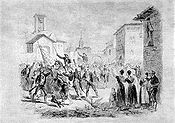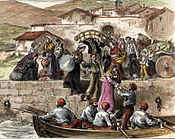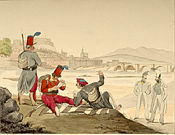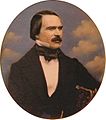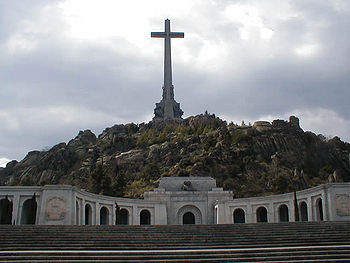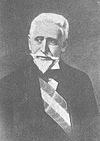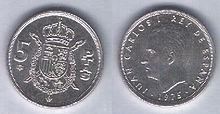- Carlism
-
Part of a series on Carlism 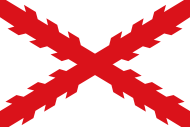 CharacteristicsTraditionalism · Catholicism · Patriotism · Monarchism · Spanish Local Fueros · Counterrevolution · LegitimismGeneralCarlist WarsRelated topicsMiguelism · Vendéens · Chouans · Conservatism · Jacobitism · Cavaliers · Toryism · Sanfedismo · Veronese Easters · Viva Maria · Cristeros · Juan Donoso Cortes
CharacteristicsTraditionalism · Catholicism · Patriotism · Monarchism · Spanish Local Fueros · Counterrevolution · LegitimismGeneralCarlist WarsRelated topicsMiguelism · Vendéens · Chouans · Conservatism · Jacobitism · Cavaliers · Toryism · Sanfedismo · Veronese Easters · Viva Maria · Cristeros · Juan Donoso CortesSpain portal
Politics portalCarlism is a traditionalist and legitimist political movement in Spain seeking the establishment of a separate line of the Bourbon family on the Spanish throne. This line descended from Infante Carlos, Count of Molina (1788–1855), and was founded due to dispute over the succession laws and widespread dissatisfaction with the Alfonsine line of the House of Bourbon. The movement was at its strongest in the 1830s but had a revival following Spain's defeat in the Spanish-American War in 1898, when Spain lost its last remaining significant colonies, Cuba, Puerto Rico and the Philippines.
An exceptionally long-lived movement, it was a significant player in Spanish politics from 1833 until the end of the Franco regime in 1975 as a social and political force, and one of the main actors in the Spanish Civil War.
In this capacity, it was the cause of several major wars during the 19th century, and an important factor during the Spanish Civil War in the 1930s.
Contents
Origins
The dynastic issue
Systems of succession in dispute
Traditionally, all the Spanish kingdoms allowed the succession of women, in absence of male direct issue, except Aragon to some extent which favored semi-salicism. The most elaborate rules of succession were those included in the Siete Partidas, but on the accession of Philip V (who was a French prince, France being a country where Salic law applied, and therefore female succession was not permitted), this traditional order of succession had to give way to a semi-Salic system, which excluded women from the crown, unless all the male issue from Philip, in any line, became extinct. This change was probably forced by external pressure to avoid any possible personal union of the Crown of Spain with a foreign monarchy (the War of the Spanish Succession had been fought to prevent Spain and France from being ruled by the same king).[citation needed]
Although several attempts to revert to the traditional order were made, such as the Decree of 1789 by Charles IV of Spain (see below), the succession question only became pressing when, by 1830, Ferdinand VII found himself ailing, without any issue but with a pregnant wife. He decided in 1830 to promulgate the 1789 decree, making the unborn child his heir regardless of its sex. The law placed the child, which would be born a girl, ahead of Ferdinand's brother Infante Carlos, who until then had been heir-presumptive.
The act was seen by some (starting with his brother and the cadet Bourbon branches) as illegal on various counts, and formed the basis for the dynastic Carlist party, which only recognized the semi-Salic succession law that gave Infante Carlos precedence over Ferdinand's daughter, the future Isabella II.[1]
Historical Timeline
- 13 May 1713: Philip V, first of the Spanish Bourbons, together with the Cortes, Spain's traditional parliament, through an Auto Accordado changes the order of succession to the Spanish crown from that outlined in the Siete Partidas. Where the old rules had involved a form of male-preference primogeniture, Philip's new law changed the rule of succession to semi-Salic law, under which succession is only possible through the female line in the absence of any male heir on any line.
- 1789: During the reign of Charles IV, the Cortes approves a reversal of the system of succession to the traditional Siete Partidas order of succession. However, the law was not promulgated, due in part to protests from the cadet branches of the House of Bourbon (House of Bourbon-Two Sicilies and House of Bourbon-Parma), who saw it as diminishing their rights.
- 1812. A new Spanish Constitution outlines the rules of succession in accordance with the Siete Partidas.
- 31 March 1830: Ferdinand VII, at the time without issue and his fourth wife pregnant, promulgates via the Pragmatic Sanction of 1830 the 1789 law, re-establishing the traditional order of succession.
- 10 October 1830: A girl, the future Isabella II is born. After several courtly intrigues, the Pragmatic Sanction is definitively approved in 1832. Ferdinand's brother, the Infante Carlos, up to that time the heir presumptive, feels robbed of his rights, and leaves for Portugal.
The political issue
Carlism confronted not only the question of who could legitimately sit on the Spanish throne, but was also about the principles on which Spanish society was built. Should it remain Roman Catholic, or should it embrace Enlightenment values? Do governments derive their power from God, or do they derive their power from human beings?
Political landscape after the death of Fernando VII (1833)
Like many European countries, after the Napoleonic occupation, the Spanish political class was split between the "absolutists", supporters of the ancien régime, and the Liberals, influenced by the ideas of the French Revolution. Both parties had fought Napoleon side by side in the Peninsular War.
The long war also left a large supply of experienced guerrilla fighters and an oversized army officialdom—for the most part, staunch Liberals. The perceived success of the uprising of 1808 against Napoleon left also a wide, if unconscious, belief in the validity of the right of rebellion, with long-lasting effects on the politics of Spain and Spanish America through the 19th century and beyond.
The reign of Ferdinand VII proved unable to overcome the political divide or to create stable institutions. The so-called Liberal Triennium (1820–1823), when, after a military "pronunciamiento", the Liberals reinstated the 1812 constitution, and the succeeding the Ominous Decade (1823–1833), ten years of absolute rule by the king, left bitter memories of persecution in both parties.
While in power, both groups had divided themselves into moderate and radical branches. The radical branch of the absolutists (or royalists), known as the Apostólicos, looked upon the heir presumptive, Carlos, as its natural head, as he was profoundly devout and, especially after 1820, staunchly anti-liberal.
In 1827, Catalonia was shaken by the rebellion of the Agreujats or Agraviados ("the Aggrieved"), an ultra-absolutist movement, which, for a time, controlled large parts of the region. The Infante was for the first time then hailed as King. He denied any involvement.
The last years of King Ferdinand saw a political realignment due to the troubles around his succession. In October 1832, the King formed a moderate royalist Government under Francisco Cea Bermúdez, which tried, almost successfully, to curb the Apostolic party and, through an amnesty, to gain liberal support for Isabella's right to succeed and for Queen Maria Christina of Bourbon-Two Sicilies, her mother and designated regent. If only to get rid of Don Carlos, the Liberals accepted the new Princess of Asturias.
Moreover, the first years of the 1830s were influenced by the failure of the French Restoration, which meant the end of Bourbon rule in France; and the civil war in Portugal between both legitimist and liberal parties.
Social and economic factors
Beside this political evolution, the years before the Carlist wars were marked by a deep economic crisis in Spain, partly spurred by the loss of the continental American provinces, and by the bankruptcy of the state. The last triggered enhanced tax pressure which further fueled social unrest.
Certain economic measures proposed by the Liberals (like the Desamortización, i.e. the takeover, division and sale of the commons and Church property, initiated in 1821) were directly threatening to the viability of many small farms, whose inhabitants could rely on the common pasture lands to feed, at little or no cost, their mules and oxen, and caused widespread poverty and the closing down of most hospitals, schools and other charities.
One important factor was the religious question. The radical liberals (progresistas) after 1820 had grown more and more anticlerical, with special hatred for regular orders, and were suspected of being masonic shields. This policy alienated them from many sections of the (mostly deeply Catholic) Spanish people, especially in rural areas.
Incidentally, the only institution abolished in the "Liberal Triennium", which was not restored by Ferdinand VII, was the Inquisition. One of the demands of the radical absolutist party was its reinstitution.
Liberals had been, while in power, quite doctrinaire, and therefore centralizing uniformists. In many sections of Spain, there were intense particularist feelings, who were thus hurt. While only a secondary element at the outbreak of the first War, this anti-uniformism or local particularism, exemplified in the defense of the fueros, would become in time one of the more important banners of Carlism. This won Carlism support in the Basque Country and Navarre, as well as the realms of the Crown of Aragon (Aragon, Catalonia and Valencia), as those areas resented the abolition of their ancient privileges of self-government by the Nueva Planta Decrees.
History
The history of Carlism can be usefully divided into three different stages, whose dates are only approximate (thus the overlap is intentional):
- (1833–1876), where the conquest of power was tried mainly by military means.
- (1868–1936), where Carlism reverted to a peaceful political movement.
- (1936–) From the Spanish Civil War until the present. The Carlists win the war as part of Franco's coalition but are also subverted by the general. After his death the movement declined into near irrelevance.
Carlist Wars (1833–1876)
 Attack on the bridge of Luchana, near Bilbao during the first war.
Attack on the bridge of Luchana, near Bilbao during the first war.
 An 1846 rendition of the executions ordered by Maroto in Estella (1839)
An 1846 rendition of the executions ordered by Maroto in Estella (1839)
The period of the Carlist Wars, in which the party tried to attain power mainly through military means, is both the classical in terms of political history as, because of the wars — or the threat of them — Carlism was at the center stage; and formative as it is the period where the cultural and sociological Carlist world, that would last for well over a hundred years, took shape.
Historical highlights of this era are the
- First Carlist War (1833–1840)
- The Royal Marriage Affair 1845. As a means to end the dynastic strife, Jaime Balmes started a campaign to marry Isabel II with Carlos, Count of Montemolin. It came close to success, but the political issues prevented it.
- Second Carlist War (1847–1849)
- The 1860 expedition and its aftermath. That year the Count of Montemolín, tried to gain power through a pronunciamiento. He landed in Sant Carles de la Ràpita (Tarragona), but was quickly detained, and forced to abdicate his rights. This disaster, his behaviour after his release, and the fact that the next in the line was his liberal brother, put Carlism on the brink of extinction, only saved by the hand of his stepmother, the Princess of Beira, and
- The "Glorious Revolution" 1868. Isabel (II) managed to alienate almost everybody in Spain, until she was expelled that year by a progressivist revolution.
At that point, Carlism, under its new head Carlos VII, became the rallying point for many political Catholics and conservatives, becoming the main group of the right-wing opposition to the ensuing governments in Spain. After four years of political activity, and some hesitations, the war option was again tried in
- the Third Carlist War (1872–1876)
Points of convergence
All three wars share a common development pattern:
- A first stage of guerrilla activity, across all of Spain.
- A second stage, where a territorial basis is created, and regular army units are created. The 1847 war did not get further than this.
- A third stage, where the basis is consolidated through conventional warfare, and State structures are created. No Carlist war went further than this.
At the beginning of each war, no regular army unit was on the Carlist side, and that only the third was the result of a planned uprising.
The first war was noteworthy for being, on both sides, extremely brutal. The Liberal Army mistreated the population, most of whom it suspected of being Carlist sympathizers, to the point of, sometimes, attempted extermination; Carlists, very often, treated Liberals no better than they had treated Napoleonic soldiers and agents), to the point where the international powers forced the warring parties to recognize some rules of war, namely the "Lord Eliot Convention". Brutality did not disappear completely, and giving no quarter was not uncommon.
The areas over which Carlism could establish some sort on territorial authority during the first war (Navarre, Rioja, rural Basque Country, inner Catalonia and northern Valencia region) would remain the main holdings of Carlism for all its history, although the movement was actively supported everywhere else in Spain. Especially in Navarre, Asturias, and parts of the Basque Provinces, Carlism was a major political force until the late 1960s.
Carlist military leaders
- Tomás de Zumalacárregui
- El Cura Santa Cruz
- Ramón Cabrera
Other military leaders
Carlists in peace (1868–1936)
The loss of prestige and subsequent fall of Isabel (II) in 1868 plus the staunch support of Carlism by Pope Pius IX, led a sizable number of former Isabelline conservative Catholics (Francisco Navarro Villoslada, Antonio Aparisi, Cándido Nocedal, Alejandro Pidal,…) to join the Carlist cause. For a time, even beyond the start of the third war (1872), it became the most important, and best organized, "right-wing" opposition group to the revolutionary regime, with some 90 members of parliament in 1871.
After the defeat, a group (led by Alejandro Pidal) left Carlism to form a moderate, non-dynastic Catholic party in Spain, which latter merged with the conservatives of Antonio Cánovas del Castillo.
In 1879 Cándido Nocedal was charged with the reorganization of the party. His main weapon was a very aggressive press; (in 1883 Pope Leo XIII published the encyclical Cum Multa trying to moderate it). His stance was an uncompromising hold to the Carlists' political and, especially, religious principles (to their integrity, hence the term "integrist"). This tendency became so radical that in 1888, Carlos VII had to expel the group centered around Ramón Nocedal, Cándido's son, which thus gave rise to another small, but in clerical circles influential, Integrist Party.
Meanwhile, the Marquis of Cerralbo, built up a modern mass party, centered around the local assembly houses (called "Círculos", of which several hundred existed all around Spain in 1936) and their social action, and in an active participation in opposition to the political system of the Restoration (participating even in wide coalitions like 1907's "Solidaritat Catalana", with regionalists and republicans).
From 1893 to 1918, Juan Vázquez de Mella was its most important parliamentary leader and ideologue, seconded by Víctor Pradera, who had wide influence in Spanish conservative thinking beyond the party.
World War I had a special influence on Carlism. As the Carlist claimant, then Don Jaime, had close links with the Russian Imperial Family, had been unfairly mistreated by Austrian Emperor Franz Josef, and was also Head of the House of Bourbon, he favoured the Allies, but was living under house-arrest in Austria, with almost no communication with the political direction in Spain. As the war ended, and Don Jaime could again freely communicate with Spain, the crisis erupted, and Vázquez de Mella and others had to leave the party's direction (the so-called "mellists").
In 1920, Carlism helped to found the "Sindicatos Libres" (Catholic Labour Unions).
Miguel Primo de Rivera's dictatorship (1923–1930) was opposed, but ambiguously viewed by Carlism; which, like most parties, entered a period of slumber, only to be awakened by the coming of the Second Republic in 1931.
Integrists and "Mellists" soon reunited, and a new flow of Catholics scared by the attitudes of the republican government started to come in. The two first years of the republic saw short-lived attempts of coalitions with Basque nationalists (as Catholic integrists) and/or Alfonsine monarchists.
After the October 1934 Revolution, Carlism started to prepare for an armed clash with the revolutionaries.
Spanish Civil War and post war period (1936-today)
During the war (1936–1939)
The Carlist militia, the Requetés, had been receiving military training during the Second Spanish Republic but had significant ideological differences with many of the conspiring generals. With the July 1936 revolt and the ensuing Spanish Civil War, the Carlists fell naturally if uneasily on the side of the Nationalist rebels. From the start there were serious troubles between the Carlists, led by Manuel Fal Condé, and the rebel military government. On 8 December 1936, Manuel Fal Conde had to leave temporarily for Portugal after a major clash with Francisco Franco.
On 19 April 1937 the Carlist political branch was "unified" with the Falange under the pro-Franco umbrella nationalist party Falange Española de las Juntas de Ofensiva Nacional Sindicalista or FET. Unwilling to leave the Nationalist movement, but unhappy with the merger, Don Javier condemned the Carlists who joined the new party and was expelled from the country while Fal Conde was not allowed to return to Spain until after the war. Low-level Carlists, with the notable exception of those in Navarre, generally distanced themselves from the workings of the new party and in many cases never joined at all.[2]
Franco era
From this time on, the mainstream kept an uncomfortable minority position inside the regime, more often than not at odds with the official policy, but with the ministry of Justice thrice given to a loyal "Carlist", who was accordingly expelled from the Traditionalist Communion. This time was also marred by the problem of succession (see below) and internal strife on how to deal with Francoism.
Carlist ministers in Franco's August 1939 cabinet included General José Enrique Varela as army minister and Esteban Bilbao as minister of justice.[3] At the same time, two of nine seats in the Junta Política were given to Carlists and of the hundred-member National Council of the FET, seven were occupied by Carlists.[4]
Carlists continued to clash with Falangists, notably in an incident at Bilbao's Basilica of Begoña on August 16, 1942. Accounts of the violence vary, but a Carlist rally (where some attendants allegedly were shouting anti-Franco slogans) was targeted by two grenades hurled by Falangists. While the number of injuries and whether any fatalities resulted have been long disputed, the incident led to a shakeup of the Franco cabinet and the conviction of six Falangists. (One, Juan José Domínguez, was executed for the crime.)[5]
Franco recognized both the titles of nobility conceded by the Carlist claimants and those of the Isabelline branch. At his death, the movement was badly split, and unable to get wide public attention again.
In 1971, Don Carlos Hugo founded the new Carlist Party based on the confederalist view of Las Españas for Spain and socialist autogestion (then promoted in Yugoslavia). At Montejurra, on 9 May 1976, two Hugo supporters were killed by far-right militants, among whom was the Stefano Delle Chiaie. Carlist Party accused Hugo's brother, Sixto Enrique de Borbón of helping the far-right militants. Traditionalist Communion denies such collaboration.[6]
Post-Franco
In the first democratic elections on 15 June 1977, only one Carlist senator was elected, journalist and writer Fidel Carazo from Soria, who ran as an independent candidate. In the parliamentary elections of 1979, rightist Carlists integrated in the far-right coalition Unión Nacional, that won a seat in Congress for Madrid; but the elected candidate was not a Carlist himself. Since then, Carlists have remained extra-parliamentary, obtaining only town council seats.
As of 2002 Hugo donated the House's archives to the Archivo Histórico Nacional, which was protested by his brother Sixtus Henry and by all Carlist factions.
Carlist claimants to the throne
The ordinals are those used by their supporters. While they were not proclaimed kings, they went by using some of the titles collateral to the Spanish throne.
Carlos V
Infante Carlos, Count of Molina (29 March 1788 – 10 March 1855), was the first Carlist claimant from 1833 to 1845, including during the First Carlist War. He was known as the Count of Molina. He abdicated in favour of his son.
Carlos VI
Carlos, Count of Montemolin (31 January 1818 – 13 January 1861), was the son of Carlos V. He was Carlist claimant from 1845 to 1861, and was known as the Count of Montemolin.
In 1860 he abdicated, following his capture by Isabelline forces, in Tortosa. When freed, he re-assumed his claim until he died the next year.
Juan III
Juan, Count of Montizón (15 May 1822 – 21 November 1887), was the brother of Carlos VI. He was Carlist claimant from 1860 to 1868, and was known as the Count of Montizon.
He was forced to abdicate by the Carlists due to his liberal leanings.
In 1883 he became the legitimist claimant to the throne of France.
Carlos VII
Carlos, Duke of Madrid (30 March 1848 – 18 July 1909), was the son of Juan III. He was Carlist claimant from 1868 to 1909, including during the Third Carlist War. He was known as the Duke of Madrid.
He was also legitimist claimant to the throne of France, using the title Duke of Anjou.
Jaime III
Jaime, Duke of Madrid (27 June 1870 – 9 October 1931), was the son of Carlos VII. He was Carlist claimant from 1909 to 1931, and was known as the Duke of Madrid.
He was also the legitimist claimant to the throne of France, using the title Duke of Anjou.
Alfonso Carlos I
Alfonso Carlos, Duke of San Jaime (12 September 1849 - 29 September 1936), was uncle of Jaime III and younger brother of Carlos VII. He was Carlist claimant from 1931 to 1936, and was known as the Duke of San Jaime. He was the last male-line descendant of Carlos V.
He was also the legitimist claimant to the throne of France, using the title Duke of Anjou.
The succession after Alfonso Carlos
At the death of Alfonso Carlos in 1936 most Carlists supported Prince Xavier of Bourbon-Parma whom Alfonso Carlos had named as regent of the Carlist Communion.
A minority of Carlists supported Alfonso XIII, the exiled constitutional king of Spain, who was the senior male descendant of King Charles IV. The majority of Carlists, however, considered that Alfonso was disqualified because he did not share the Carlist ideals (and, more importantly, because Spanish law[7] excluded from succession the descendants of those who had committed treason against the king, just as Alfonso's male-line ancestors had done, according to carlists, ever since Infante Francisco de Paula's recognition of Isabella II) , and many regarded his descent as illegitimate, believing that Alfonso XII's biological father was Isabella II's lover Enrique Puigmoltó y Mayans, Captain of the Royal Guard, or even General Francisco Serrano.
A small number of Carlists supported Archduke Karl Pius of Austria, Prince of Tuscany, a grandson through the female line of Carlos VII.
Most of the following events happened under Franco's regime, which skillfully played each group against the others.
Borbón-Parma claim
- Francisco Javier I[8]
Xavier, Duke of Parma (25 May 1889 - 7 May 1977) had been named regent of the Carlist Communion by Alfonso Carlos in 1936 as he was the nearest member of the House of Borbón who shared the Carlist ideals.
During the Second World War, Prince Xavier returned to the Belgian army, where he had served during World War I. He was demobilized and joined the French maquis. He was taken prisoner by the Nazis and sent to Natzweiler and the Dachau concentration camp, where American troops liberated him in 1945. In 1952, Xavier was proclaimed King of Spain, assuming the Carlist legitimacy. Since the death of Alfonso Carlos I, his successor, by right of agnation and primogeniture, had yet to be determined. To do so, it was necessary to trace back into the line of Philip V to his eldest descendant not excluded by law (exclusion took place for treason, morganatic marriage, and other reasons as legally established in the Novísima Recopilación of 1805, in force at the time of the First Carlist War). In 1952, when all lines senior to the House of Bourbon-Parma (descended from Duke Philip of Parma, third son of Philip V) were definitely excluded for any of these reasons, legitimacy befell on Xavier I. Thus, even though he was close to Carlism from an early age and was named regent of the Carlist Communion in 1936, his proclamation as King later in 1956 was not a political move based on ideology, but the consequence of dynastic legitimacy. He was known as the Count of Molina. He remained Carlist claimant until he abdicated in 1975.
Political division due to the changes in Carlism in the late 1960s and early 1970s, brought a sharp division of Xavier's supporters between his two sons Carlos Hugo and Sixto Enrique (and many more endorsing neither). Carlos Hugo turned organized Carlism into a socialist movement, while his brother Sixto Enrique (supported by his mother Madeleine de Bourbon-Busset) followed a far rightist course.
In 1977 Sixto Enrique's supporters published a manifesto from Javier condemning Carlos Hugo. Several days later Carlos Hugo's supporters published a manifesto from Xavier recognising Carlos Hugo as heir.
- Carlos Hugo I[8]
Carlos Hugo, Duke of Parma (8 April 1930- 18 August 2010) was the elder son of Xavier. He was Carlist claimant from 1977 until his death and was known as the Duke of Madrid. After alienating many Carlists by his attempts of an approach to Franco (1965–1967), Carlos Hugo switched to a leftist Titoist, workers' self-management socialist movement. In 1979 he accepted Spanish citizenship from King Juan Carlos I. In 1980 he renounced his membership in the Partido Carlista which he had created. Carlos Hugo had the support of a minority of Carlists including the Partido Carlista. He also excluded the Luxembourgish branch of the family from Carlist succession due to the many unequal, some of them at least as so considered, marriages celebrated by its princes.
- Carlos VIII
Carlos, Duke of Parma (born 27 January 1970) is the elder son of Carlos Hugo. He inherited the Carlist claim on his father's death in 2010. Carlos has the support of a minority of Carlists including the Partido Carlista.
- Sixto Enrique
Prince Sixto Enrique of Bourbon-Parma (born 22 July 1940) claims to be the current regent of the Carlist Communion. He is known as the Duke of Aranjuez.
Sixto Enrique is supported by the minority Comunión Tradicionalista, and some others, who believe that his brother Carlos Hugo was rightful heir, but ineligible for the succession on account of his socialism. Sixto Enrique has never claimed to be Carlist king, in the hopes that one of his nephews will one day accept traditional Carlist values.
Borbón claim
- Alfonso de Borbón
Alfonso XIII was the senior member of the House of Borbón at the death of Alfonso Carlos in 1936. He had reigned as the constitutional king of Spain as Alfonso XIII until his exile in 1931. He was the son of King Alfonso XII, son of Francisco de Asis de Borbón, son of Infante Francisco de Paula, the younger brother of Carlos V. He was recognised as Carlist claimant by a minority of Carlists who considered the death of Alfonso Carlos an opportunity to reunite Spanish monarchists both Carlist and Isabelline. Nonetheless, despite this apparently attractive opportunity, Franciso de Paula and his descendants were legally excluded[9] from the throne according to the Spanish laws of succession as they stood in 1833 (and therefore defended by Carlists since then). In 1941 Alfonso abdicated; he died two months later.
Alfonso's eldest son had died in 1938. His second son Jaime had been forced to renounce his rights to the constitutional succession in 1933. His third son Juan was his chosen successor.
The 5 pesetas coin of 1975 featured the official king, Juan Carlos I of Spain and a coat-of-arms with the San Andrés salitre, Carlists' assumed symbol.
- Juan de Borbón claim
-
- Infante Juan, Count of Barcelona (20 June 1913 – 1 April 1993) was the third son of Alfonso. He was claimant to the throne of Spain from 1941 until his renunciation in 1977. In 1957, a small group of former Carlists had recognized him as their Head in his exile at Estoril, Portugal.
- King Juan Carlos I is the son of Infante Juan. He is the current representative of this claim. He has been the King of Spain since 1975, confirmed by the Spanish Constitution of 1978.
- Jaime de Borbón claim
-
- Infante Jaime, Duke of Segovia was the second son of Alfonso, and the older brother of Juan, Count of Barcelona. In 1960 Jaime announced that he was Carlist claimant and began using the title Duke of Madrid; he remained Carlist claimant until his death in 1975. He had only a few Carlist supporters, but among these was Alicia de Borbón y de Borbón-Parma, the only surviving daughter of Carlos VII. Jaime was also legitimist claimant to the French throne, using the title Duke of Anjou; in this capacity he had substantial supporters.
- Alfonso, Duke of Anjou and Cádiz was the son of Jaime. He did not claim the Carlist succession between 1975 and his death in 1989.
- Louis Alphonse, Duke of Anjou is the son of Alfonso. He has never claimed the Carlist succession.
Habsburgo-Borbón claim
The eldest daughter of Carlos VII was Bianca de Borbón y Borbón-Parma (1868–1949). She married Archduke Leopold Salvator of Austria (1863–1931). In 1943, one of their sons presented himself as Carlist claimant in succession to his great-uncle Alfonso Carlos. Since this claim comes through a female line, it is rejected by most Carlists.
- Archduke Karl Pius of Austria, Prince of Tuscany was Carlist claimant from 1943 to 1953. He was supported by some of General Franco's officials from the Movimiento Nacional. As he assumed the title of "King Carlos VIII", the movement that supports this branch of the family is called carloctavismo.
- Archduke Anton of Austria was the brother of Karl Pius and was Carlist claimant (Carlos IX) from 1953 to 1961.
- Archduke Franz Josef of Austria was the brother of Karl Pius and Anton and was Carlist claimant (Francisco I) from 1961 to 1975.
- Archduke Dominic of Austria is the son of Anton and has been Carlist claimant (Domingo I) from 1975 until present. He has the support of only a tiny minority of Carlists including the Comunión Carloctavista y Círculo Carlos VIII.
Some carloctavistas consider that Dominic has contracted an unequal marriage and is thus ineligible to succeed to the throne [1]. Following the version of the succession law advocated by the carloctavistas, that if the direct male line dies out the nearest female relative of the last king inherits the crown with succession to her heirs male, then with only descent through equal marriages allowed the claim would have passed on the death of Franz Josef in 1975 to Infante Juan, Count of Barcelona. This would make the present de facto king Juan Carlos I the Carlist king, although, as all his children have contracted unequal marriages, the Carlist claim will pass on his death to Infante Carlos, Duke of Calabria. However, many Carlists regard the current de facto Spanish royal family as disqualified (see above). If Alfonso XII and his heirs are discounted, the heir to the Spanish throne under the carloctavista succession rules with descent only through equal marriages is Duarte Pio, Duke of Braganza, the current pretender to the throne of Portugal.
Ideology
Carlism or Traditionalism can be labeled as a counterrevolutionary movement.
Carlism's intellectual landscape was a reaction against the basic tenets of the Enlightenment and the French Revolution of 1789 (Laicism, individualism, egalitarianism, rationalism). In this sense, it is akin to the French Reactionaries (Legitimism) and Joseph de Maistre's thinking.
It's difficult, though, to give an accurate description of Carlist thinking for several reasons:
- As traditionalists, Carlists mistrusted ideology as a political driving force. Some 19th century pamphlets expressed it in this form: against a philosophical constitution (liberalism, based on ideology), a historical constitution is proposed (based on history, and the teachings of the Church).[citation needed]
- Carlism's long active history — it has been an important force for over 170 years — and the fact that it attracted a large and diverse following, makes a comprehensive categorization more difficult.
- There has almost never been a single school of thought inside Carlism.
- The ideas expressed inside Carlism were partly and openly shared with other forces on the political spectrum. The more conservative, Catholic (or Christian-democratic) wings of the various nationalist and regionalist movements throughout Spain can claim an indirect influence from Carlism, particularly relating to fueros and regional self-government.
While Carlism and Falangism had certain similarities- social conservatism, Catholicism and anti-Communism- there were also stark differences between the two movements. Most significant was whereas Falangism subscribed to a strongly centralising form of Spanish nationalism, Carlism was more supportive of maintaining regional identities and autonomy as fueros was one of their main tenets.
Carlism also supports Salic Law in regards to succession, being legitimist monarchists.
 Variant of the Spanish royal arms with the Sacred Heart. It was a common emblem of the Carlism supporters during the Spanish Civil War.[10]
Variant of the Spanish royal arms with the Sacred Heart. It was a common emblem of the Carlism supporters during the Spanish Civil War.[10]
Dios, Patria, Fueros, Rey
These four words (which can be translated as God, Fatherland, Local Rule, and King), have been the motto and cornerstone of Carlism throughout its existence. What Carlism understood by these was:
- Dios (God): Carlism believes in the Catholic Faith as a cornerstone of Spain, and must be politically active in its defense.
- Patria (Fatherland): Carlism is heavily patriotic, Traditionalism sees the Fatherland as the nesting of communities (municipal, regional, Spain) united under one.
- Fueros (similar to medieval charters): Part of the limitation of royal powers is the acknowledgment of local and regional self rule (and of other types of communities in the political body, especially the Church). Although the result of a peculiar historical development in Spain, it converged with the concept of subsidiarity in Catholic social thought. Note that some versions of the motto omit the Fueros clause.
- Rey (King): The concept of national sovereignty is rejected. Sovereignty is vested on the king, both legitimate in blood and in deeds. But this power is limited by the doctrine of the Church and the Laws and Usages of the Kingdom, and through a series of Councils, traditional Cortes and state-independent intermediate bodies. The King must also be the Defender of the Poor and Keeper of Justice.
Supporters
Carlism was a true mass movement and drew its rank and file from all social classes, with a majority of peasant and working class elements. Thus, it is no surprise that Carlism was involved in the creation of Catholic trade unions. It was also a family tradition, later Carlists would be descendants of earlier Carlists.
Offshoots and influence
- Cultural and political regionalism in Spain (not to be mistaken with regional nationalism or separatism) was largely Carlist-originated. The influence of Carlist thinker Juan Vázquez de Mella in this field can still be traced today.
- One of the founders of Basque nationalism, Sabino Arana, came from a Carlist background, and for many years competed for the same audience (Basque deep[clarification needed] Catholics). Compare the PNV slogan "God and Fueros". Basque nationalism, however, was effectively shaped by the Liberal Engracio de Aranzadi, an admirer of Mazzini. Carlist and Nationalists drafted the first Basque Statute of Autonomy, but Carlists battled and defeated Basque nationalists in 1936-1937.
- Fuerismo was a doctrine prevalent in the Basque provinces. It supported the Isabelline monarchy but wanted to preserve the Fuero autonomy of the provinces.
- Catholic politics[clarification needed] are essential for Carlism. Compare the slogan Christus Rex.
- Victor Pradera's thinking was very influential, through the group Acción Española, in Spanish authoritarian thinking in the 1930s and 1940s.
- On 7 May 2007, Fernando Sebastián Aguilar, Archbishop of Pamplona and Tudela (Spain) caused controversy by publicly stating that the Traditionalist Carlist Communion, among others, is worthy of consideration and of electoral support.
Symbolism
Symbols
- Motto: Dios, Patria, Fueros, Rey
- Flag: the red cross of Burgundy on white
- The red beret. In Basque, the Carlist troops were hence called txapelgorri -though the name was also shared by units of the opposing Liberal side. The red beret was worn as a distinguishing device by Carlists soldiers in the First Carlist War and later became an emblem of Carlists in general, often with a yellow pom pom or tassel.[11]
- Anthem: Oriamendi
Related words
- Estella-Lizarra was the site of the Carlist court.
- Bergara/Vergara was the place of the Abrazo de Vergara, which ended the First Carlist War in the North.
- Brigadas de Navarra were National Army units formed mainly by Requeté forces from Navarre at the start of the Spanish Civil War. They saw intensive action during the War.
- Detente bala ("Stop bullet!") a small patch with an image of the Sacred Heart of Jesus worn on the uniform (over the heart) by most requetés.
- Margaritas. Carlist women organization. They often worked as war nurses.
- Ojalateros were courtiers saying Ojalá nos ataquen y ganemos ("Wish they would attack us and we won"), but doing nothing to achieve victory. The name is a pun on hojalatero ("tinkerer", "pot-seller")
- Requeté The armed Carlist militias.
- Trágala, expression marking the desire to forcibly impose the ideas most hated by the opponents. Also a Liberal fighting song (chorus: "Swallow it, you Carlist, you who don't want a Constitution.").
Literary references to Carlism
The liberal Spanish journalist Mariano José de Larra opposed Carlism and published several lampoons against it. Nadie pase sin hablar al portero (1833) presents Carlists as a bunch of bandit priests.
Karl Marx mentioned the Carlists in his articles about the Spanish revolutions. An apocryphal quotation can be found among Spanish historians, where Marx would express a view of the Carlists as a revolutionary popular movement in defence of regional liberties.
Francisco Navarro-Villoslada was a Carlist writer that published a historic novel, Amaya o los vascos en el siglo VIII, in the fashion of Walter Scott, presenting the legendary origins of Spanish monarchy as the start of Reconquista.
Ramón María del Valle-Inclán, novelist, poet and playwright, was a member of the Spanish Generation of 1898. He wrote novels about Carlism and was an active Carlist himself.
Pío Baroja wrote a novel, Zalacaín el aventurero (Zalacain the Adventurer), set during the Third Carlist War, and referred to Carlism in a not very favourable light (as he generally referred to nearly everybody) in several other works.
The Spanish philosopher Miguel de Unamuno suffered as a child the siege of Bilbao during the Third Carlist War. Later he wrote a novel Paz en la guerra about that time. In 1895 he wrote to Joaquín Costa about his plans for an essay on the "intrahistoric" element of rural socialism within the Carlist masses.
See also
- Parties and factions in Isabelline Spain
References
Notes
- ^ The causes of illegality most cited were that Fernando did not have the right to alter such a fundamental law without the support of the Cortes; that the 1789 acts of the Cortes were not valid (either because it wasn't published in a timely manner or because the procurators had no powers on this issue); or that Carlos's pre-existing rights could not be diminished retroactively by a law made in his lifetime
- ^ Payne, S.G. The Franco Regime, 1936-1975. Madison: University of Wisconsin, 1987. p 189.
- ^ Payne, S.G. The Franco Regime, 1936-1975. Madison: University of Wisconsin, 1987. p 235.
- ^ Payne 1987, p. 238.
- ^ Payne 1987, p. 306-308.
- ^ carlismo.es/montejurra (in Spanish)
- ^ In 1833, before the departure from legality that carlists saw in the accession of Isabella II, the "Novísima Recopilación" of 1805, a compilation of previous laws, was in force in Spain. It included the Fifth Law of the 32nd Title of the "Ordenamiento de Alcalá" (which in turn gave legal force to the First Law, Sixth Title of the XIIth Book of Alfonso X's "Siete Partidas"), which punished rebellion against the legitimate king with defamatory measures, such as loss of any inheritable rights. This precept was invoked by Philip V in his exclusion of the Austrian Habsburg branch after the War of Succession. It was also brought up by supporters of Isabella II, in an attempt to exclude Carlos V and his descendants from the throne (which, naturally, was not accepted by carlists on account of Isabella II's illegitimacy). When the death of Alfonso Carlos I, Bourbon male-line seniority went to the Alfonsine branch, not as descendants of Isabella II but of her husband Francisco de Asís, son of Infante Francisco de Paula (younger brother of Ferdinand VII and Carlos V). However, his recognition of Isabella II constituted sufficient basis of exclusion from succession according to the abovementioned law. Franciso de Paula's male descendants, excluded by his treason to Carlos V, furthermore persisted on recognizing Isabella II and eventually accepting their proclamation as constitutional kings. It is not surprising, then, that carlists did not consider that Alfonso XIII (and his heirs) had any rights to the throne after the death of Alfonso Carlos I, not on a purely ideological basis but also on a legal one.
- ^ a b Borbone Parma La Dinastia
- ^ See above reference. For details on exclusion from succession for treason, see Melchor Ferrer's "Historia del Tradicionalismo Español", Book II, p. 149. Ediciones Trajano.
- ^ Menéndez Pidal y Navascués, Faustino, Hugo. El escudo. P. 212. At Menéndez Pidal y Navascués, Faustino; O´Donnell y Duque de Estrada, Hugo; Lolo, Begoña. Símbolos de España. Madrid: Centro de Estudios Políticos y Constitucionales, 1999. ISBN 84-259-1074-9
- ^ p.32 MacClancy, Jeremy The Decline of Carlism University of Nevada Press, 2000
Bibliography
- Bibliographical resources:
- Other references:
- Tetralema - Bitácora Lealtad Carlist weblog
- Agencia FARO Carlist Press & Documentation Service. Some content in English
External links
- Modern Carlist groups are:
- Partido Carlista Official page of the Carlist Party
- Comunión Tradicionalista Carlista Official page of the Carlist Traditionalist Communion. Does not endorse formally any claimant
- Comunión Tradicionalista Official page of the Traditionalist Communion officially supporting Sixtus Henry as regent
- Comunión Carloctavista y Círculo Carlos VIII Unofficial page of the Charles VIII Communion, supporting Dominic Charles as claimant
- Carlism as a current topic of discussion in Spanish politics
- Ideological analysis of Carlism
- Extensive historical background
- Album de personajes carlistas con sus biografías, Francisco de Paula Oller, Barcelona, La Propaganda Catalana, Librería de Antonio Quintana y Bové, 1887. Page scans from the Navarrese Digital Library.
- Dios, Patria, Fueros, y Rey: The Story Of The Spanish Carlistas article by Eleonore Villarrubia on Catholicism.org
Wikimedia Foundation. 2010.

